In November 2009, the UTD Cave Diving Team explored the cenote known as “The Pit” located in Tulum, Mexico; part of the Yucatan Peninsula.
The Pit is comprised of break-down rooms with 100’ / 30m high ceilings and walls that are 100’+ /30m+ away from the line. These rooms are actually more like massive chambers that are connected by narrow, tight passageways (known as restrictions) which then open up to even more chambers of enormous proportions. The entirety of “the Pit” is a collection of these gargantuan rooms and restrictions linking them together.

The mission of the UTD Cave Diving Team was to (1) survey “the Pit”, (2) collect data for a 3D map, and (3) ultimately document scientific data regarding the water quality and flow systems throughout the area.
In order to meet these objectives, the team worked at depths well over 300 ft / 90m, with bottom times in excess of 2.5 hours, followed by more than seven hours of decompression obligation.
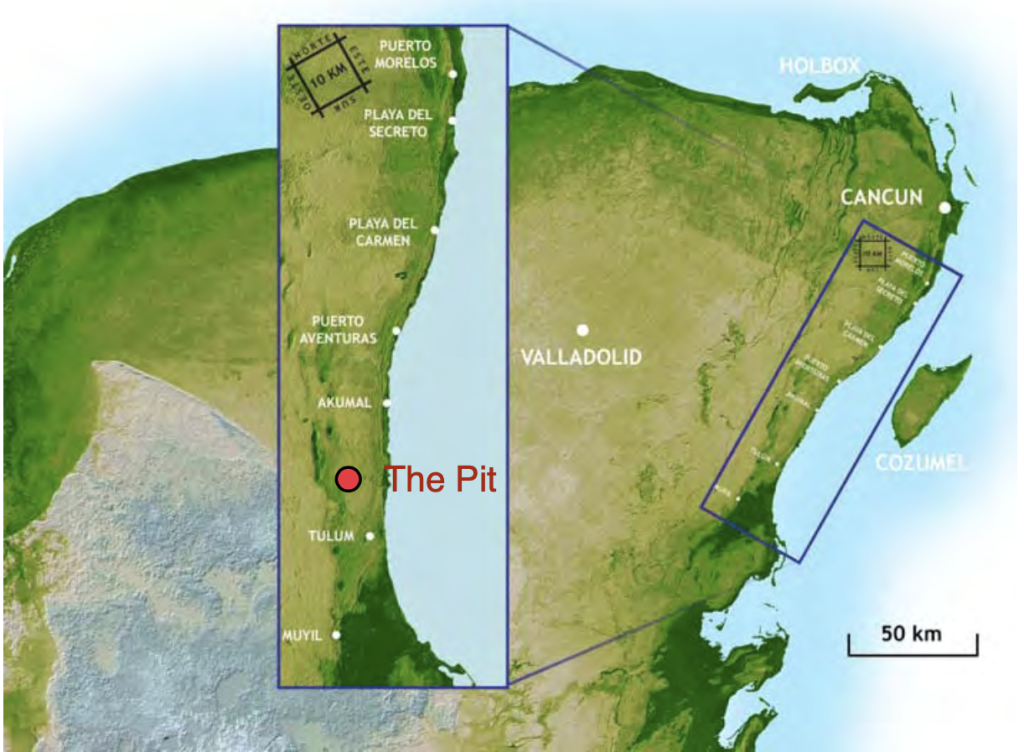
The Team:
Gathering a group of dedicated individuals to make the project a success was critical, and “The Pit” project proved to push the limits–physically and mentally–of all team members alike.
The amount of hard work needed was overwhelming at times, but the UTD Cave Diving Team dedicated countless hours to make things happen as smoothly as possible. Without the dedication of all members involved, the accomplishments made during the Pit Project would not have been realized.
I would once again like to thank everyone that made the Pit Project a success. Together, as a team, we accomplished more than I could have ever imagined.
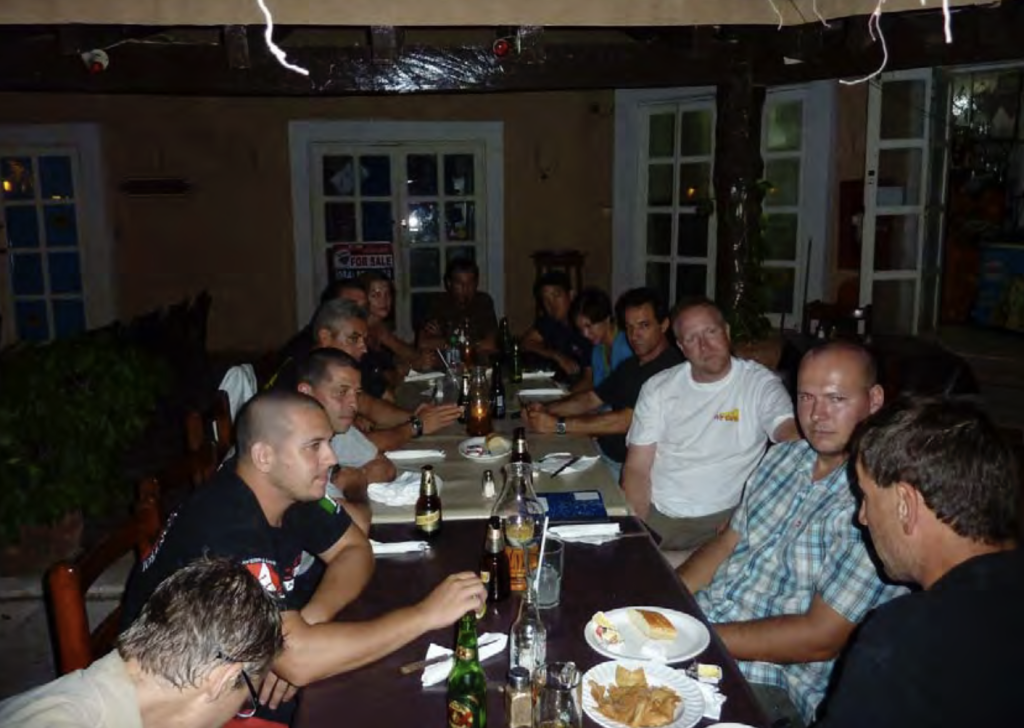
UTD Cave Team Members:
Nick Toussaint – Project Director / Rebreather Diver
Andrew Georgitsis – Rebreather Diver
Simon Richards – Researcher
Mike Netto – Deep Support
Sergi Perez -Deep Support
Andy Huber – Surface & Shallow Support
Nick Ambrose – Surface & Shallow Support
Alla Popova – Surface & Shallow Support
Gabriel Gasca – Surface & Shallow Support
Kevin Dow – Surface Support
David Dusek – Surface Support
Zed Dusek – Surface Support
Don Chennavasin – Surface Support
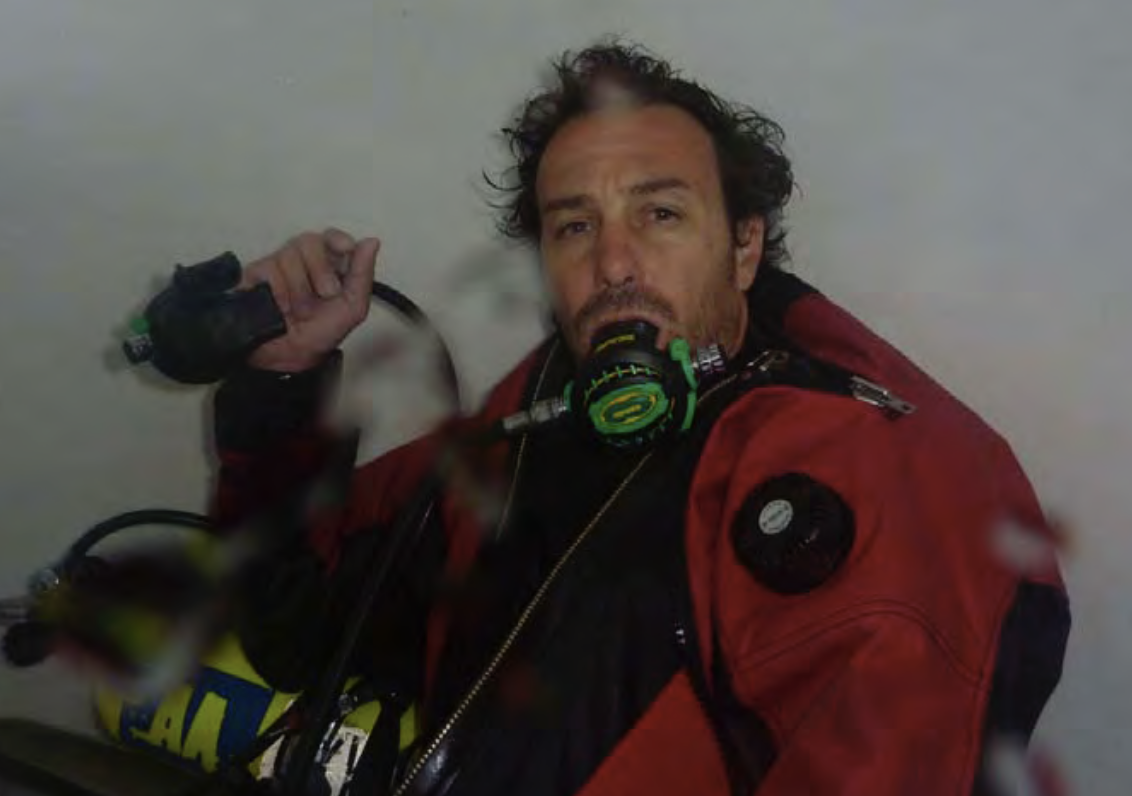
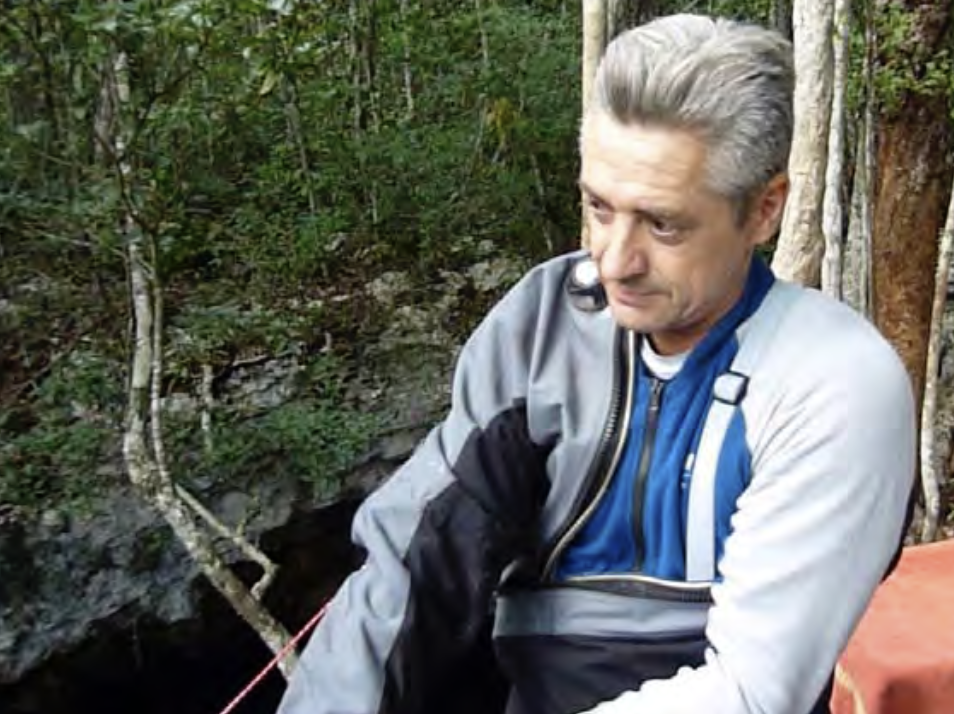
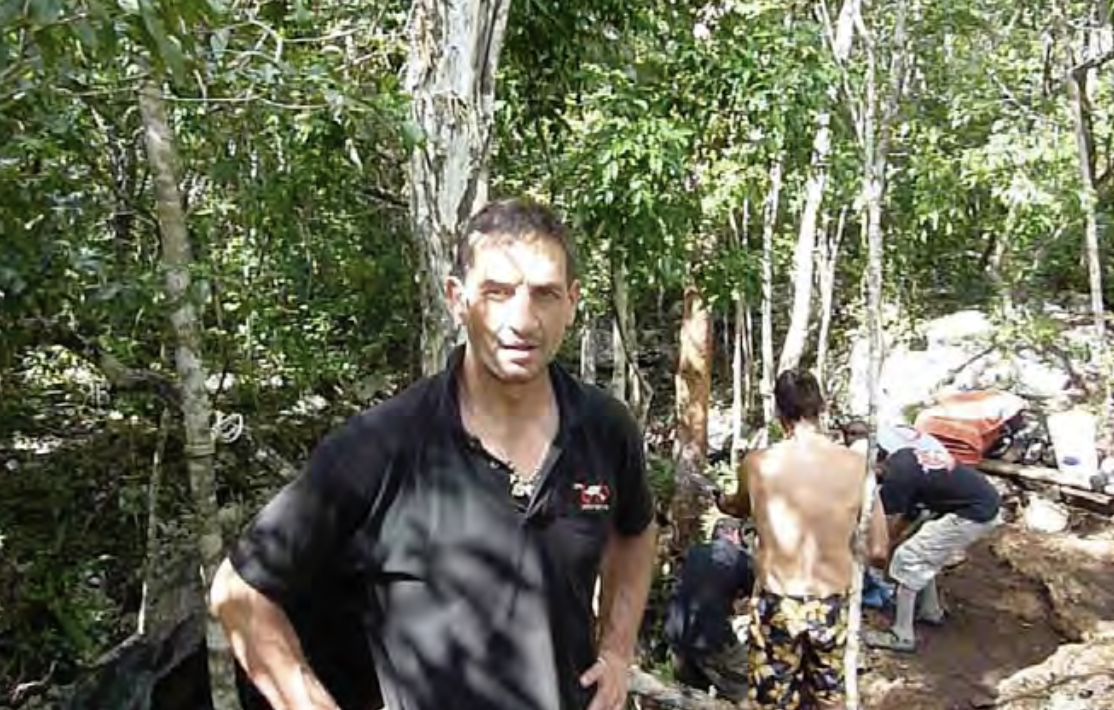
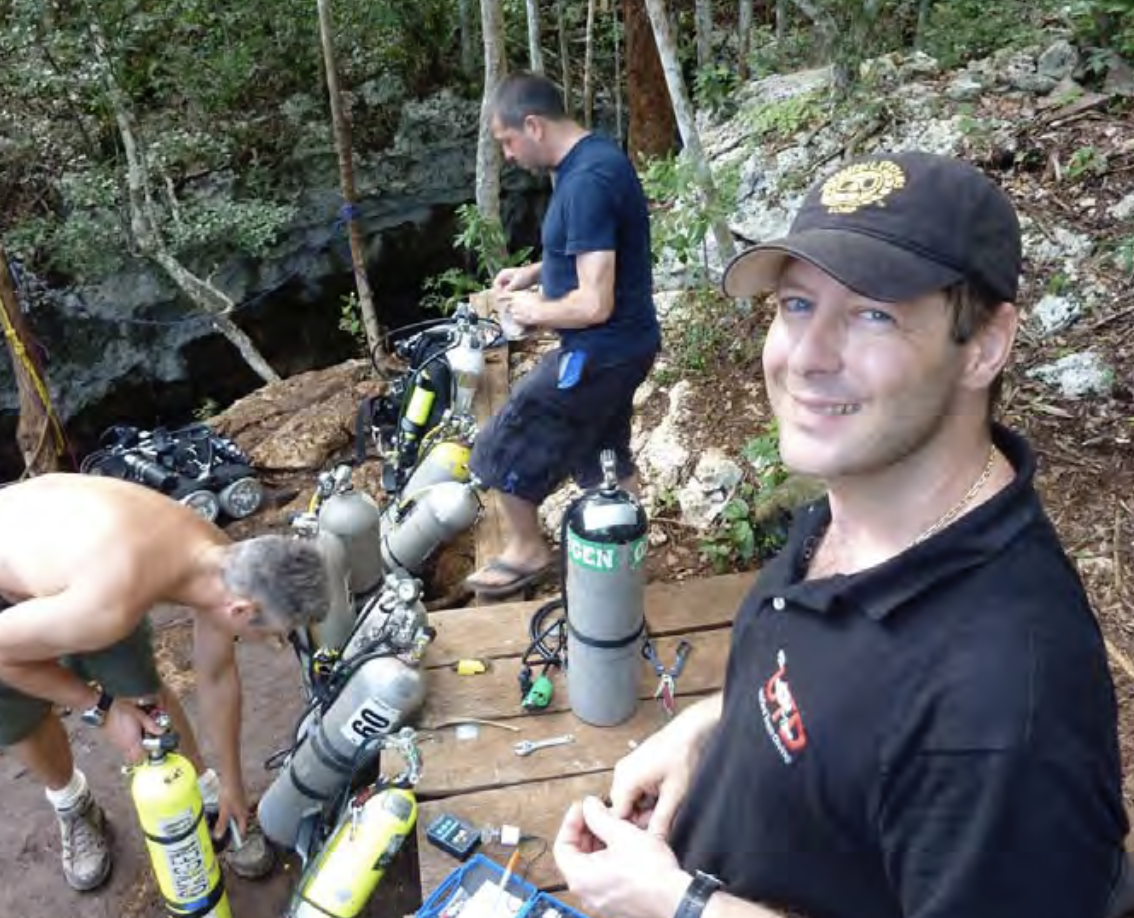



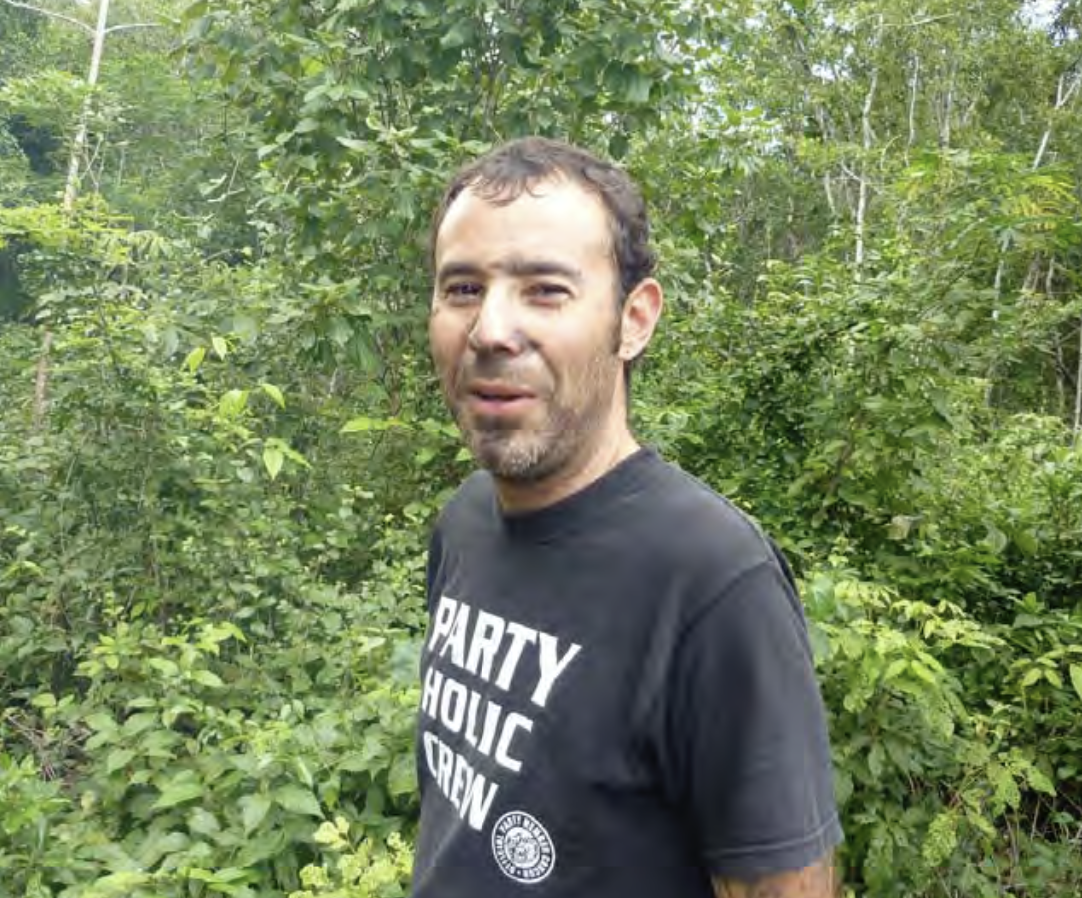
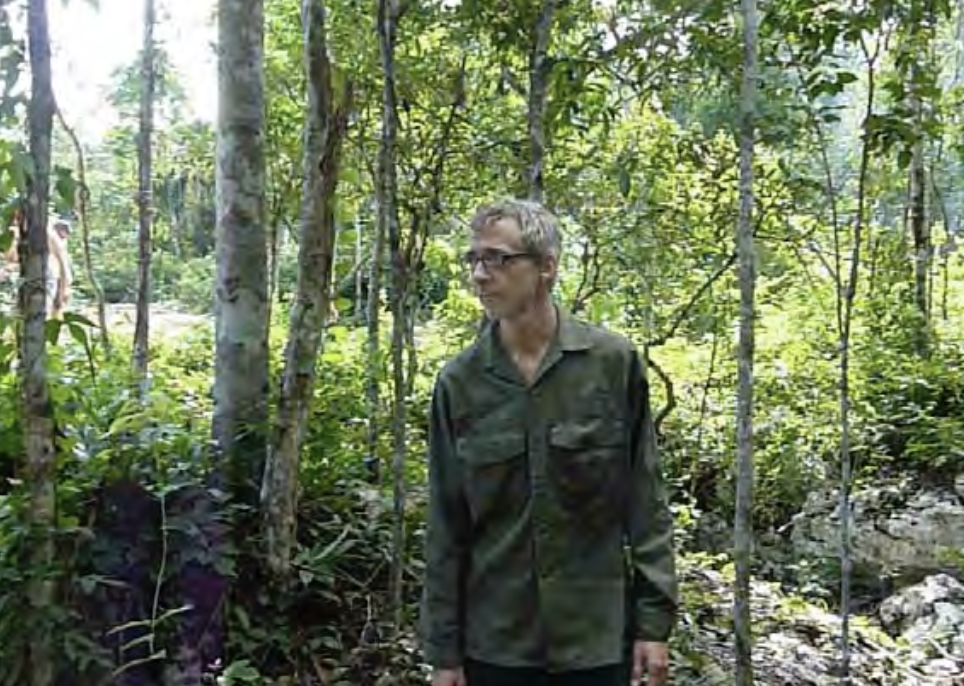

Behind The Science:
Simon Richards, a researcher, actively studies the Salinity, Dissolved O2, pH and Temperature of the water in the submerged caves in the Yucatan region. The goal is to prove the existence of different flow systems at varying depths throughout the water column. To Simon, our dives in “The Pit” are interesting because it is one of the deepest caves in the region. This provides him with unique insight into the water quality at extreme depths that cannot be acquired from other caves in the area.
The water flow system tells us how the ground water channels are all connected, especially in the deeper water systems. This will be valuable information to government officials, as hotels currently pump their sewage into the ground water at 400 ft/120m due to a lack of understanding of how these actions can negatively and catastrophically impact the entire region. Local communities survive on the water in the shallow cenotes, however, as the sewage that is pumped into the deeper water floats up; shallow drinking water systems are increasingly becoming contaminated.
For scientific research equipment, we used an Aqualab—which was carried like a stage bottle–on all dives conducted by the rebreather team. The Aqualab profiled the water for temperature, salinity, PH, depth, and dissolved O2. The findings were very interesting as we could see very definitive layers in the 38m and 52m flow systems. These layers are also evident and repeated in other deeper caves in the region, such as “Angelia”. As the result of The Pit Project, there was also indication of deeper flow systems in “The Pit”; but this is only one data point and further data collection is needed to accurately prove this.
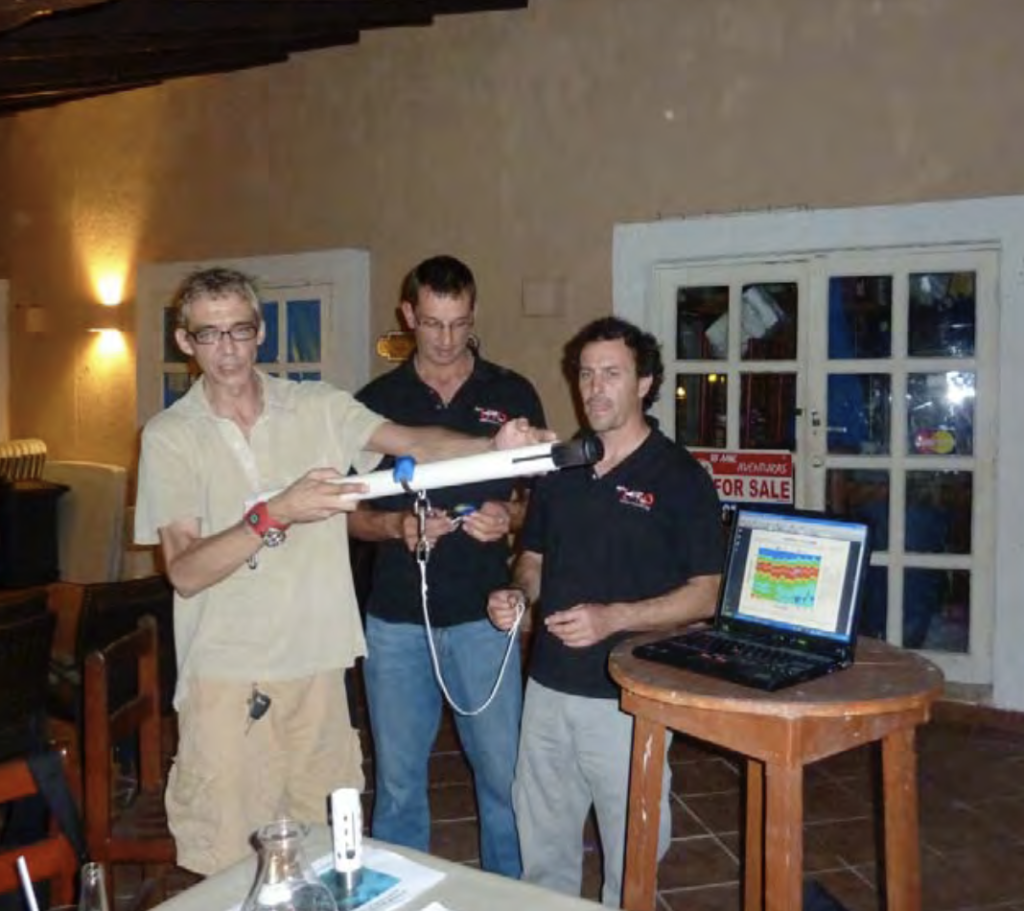
As an interesting side note, a 2006 project at “the Pit” was executed entirely on Open Circuit Scuba. The findings from the 2006 project showed many more layers or changes in temperature and/or salinity of the water. However in the 2009 project, which was done on Closed Circuit Rebreathers (CCR), those multiple layers disappeared and in the more shallow water only the 38m and 52m layers were evident in the data. This indicates that Open Circuit Scuba probably disturbed the water from the air bubbles that were released during this type of diving and therefore created false readings; whereas the data collected by CCR divers provided cleaner results.
This once again demonstrates that CCR is the right tool to use for deeper cave exploration, especially when carrying sensitive scientific equipment to accomplish specific tasks.

The “Pit” Logistics
Logistics for The Pit can be quite complex, partly as the result of its remote location. Access is along a five kilometer dirt road which is very rough – the last 300 meters requiring a true off-road vehicle.
Getting all the equipment into the area of the exploration was a task in itself.
The other major logistical complication was getting equipment into the water. The Pit is a massive hole with steep, 40ft/12m drop-offs to the water. Precipitous and slippery slopes make carrying equipment up and down incredibly difficult and dangerous.
Unlike other cenotes in the Yucatan, the site itself remains rough. Jungle like conditions with unstable rocks around the Pit made it difficult to maneuver heavy equipment to and from the cenote.
The only way to get heavy equipment – doubles, rebreathers (RBs), stages and scooters – in and out of the water is hoist the equipment down to the water utilizing a pulley system. Concerned that the existing pulley assembly would not be sufficient for our needs, we constructed a pulley system ourselves and created a winch system that could handle the heavy equipment. Even with a 3:1 ratio pulley, hauling a 200 pound / 90 kilo rebreather required three to five people.


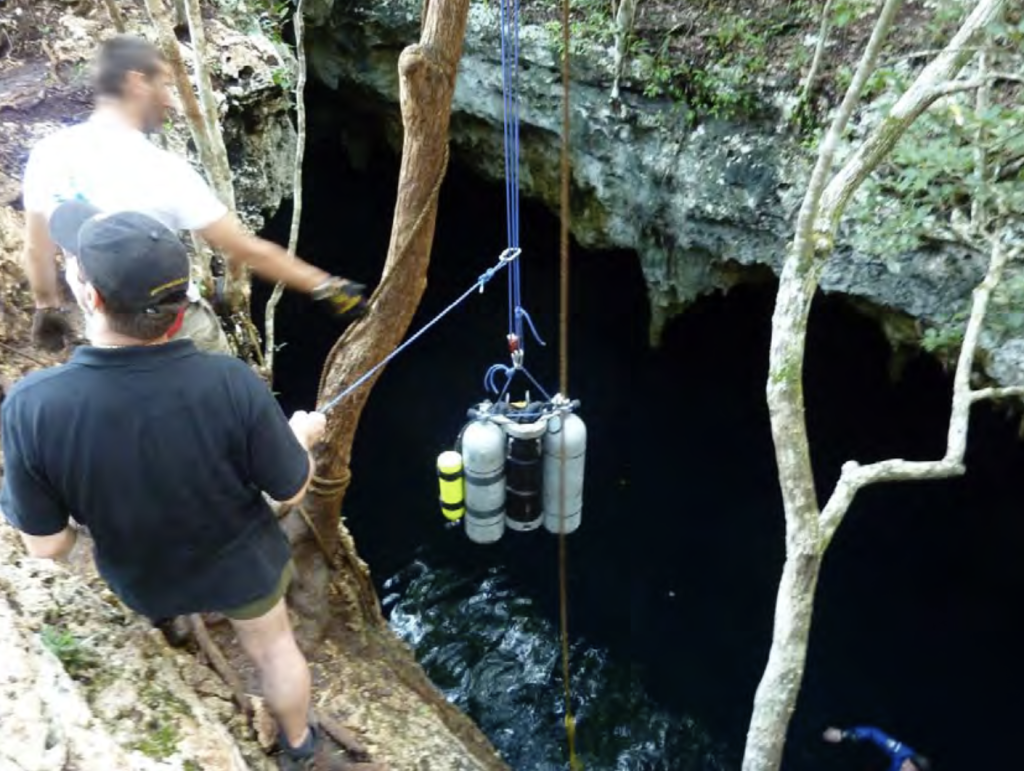
The main tasks from a logistical perspective were to-
- Ensure the correct equipment (RBs, doubles, stages, deco bottles) with the appropriate gases were delivered to the site. All gas needed to be analyzed, pressure tested and labeled appropriately.
- Ensure that equipment was working, correctly assembled, and delivered to the water at the correct time.
- Assist in removing equipment from the water that was no longer needed or needed to be refilled/recharged.
- Support the exploration, deep support, and shallow support teams as they put their equipment together, and assist in repairs when necessary.
- Remove all equipment from the site that was either no longer needed, or needed to be refilled or recharged.
The Support:
During the Pit project, every team member played a role in logistical support, from bringing along spare supplies, parts, and equipment to loading/unloading tanks, scooters and rebreathers and getting them into and out of the water. The exploration team used double LP120 tanks for their back gas, making the total RB weight considerable, and a big challenge to get into the water.
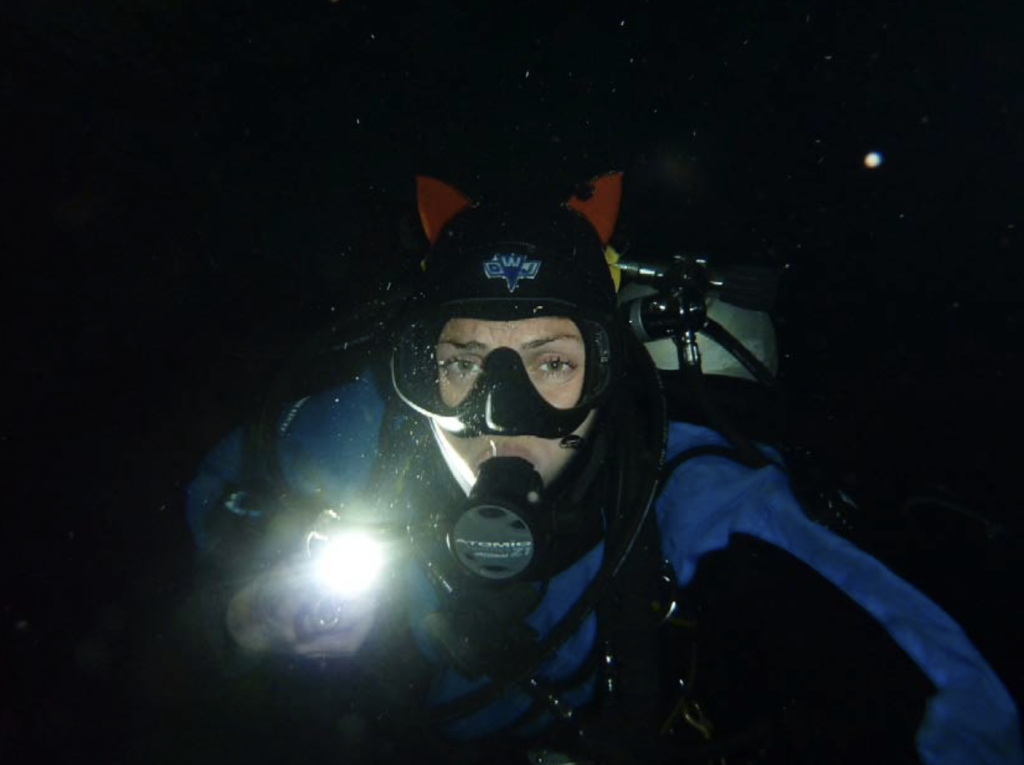
Most of the safety equipment was placed in the cave at the start of the project (the 21M, 36M and 57M bottles) and they remained in place during the project. Some of the shallower equipment (O2, weights, argon) for the habitat was removed and replaced on a daily basis.
To coordinate all efforts during the project, we had a designated Surface Manager, who was the central point of reference for everything that happened in and out of the water– controlling who and what was in the water at all times, ensuring that the correct equipment was in place, and that spent equipment was promptly removed from the site.
Each day, the Surface Manager divided the available divers into teams, and assigned each team a role – deep support, shallow support, or surface support. Each team was then assigned a series of tasks for the day, i.e., placing equipment into the cave at a certain point, removing equipment, etc.
The Surface Manager verified that all tasks were successfully completed, and that everything was in place before the exploration team set out.
Since the dive plan can change midway through the dive (if there is an issue during the dive, or if the dive is deeper, shallower, shorter or longer than planned), the Surface Manager needed to be able to respond and acclimate very quickly to sudden changes and plan around all types of events. This may include placing additional divers in the water, locating and placing more deco gas in the water, relocating gas within the cave (moving bottles to a location where they are more helpful), etc.
The Surface Manager interacted directly with the deep and shallow support divers in the water, and through them, gained an understanding of the exploration team’s needs.

Shallow Support Objectives:
Placing gear
The shallow support team was responsible for placing equipment into the cave. For the pit project, shallow support was everything shallow down to 120ft/36m. It was highly desirable for the shallow support team to avoid any mandatory decompression obligation, but in an emergency, this may have been necessary.
Equipment that may be placed into the cave includes
- Decompression bottles.
- Bottom stages (for use during the dive).
- Safety bottles (bottom stages that are for use in an emergency).
- Scooters.
- Lights, food/water, extra argon, weighted back plates and belts for when the exploration team removes their rebreathers.
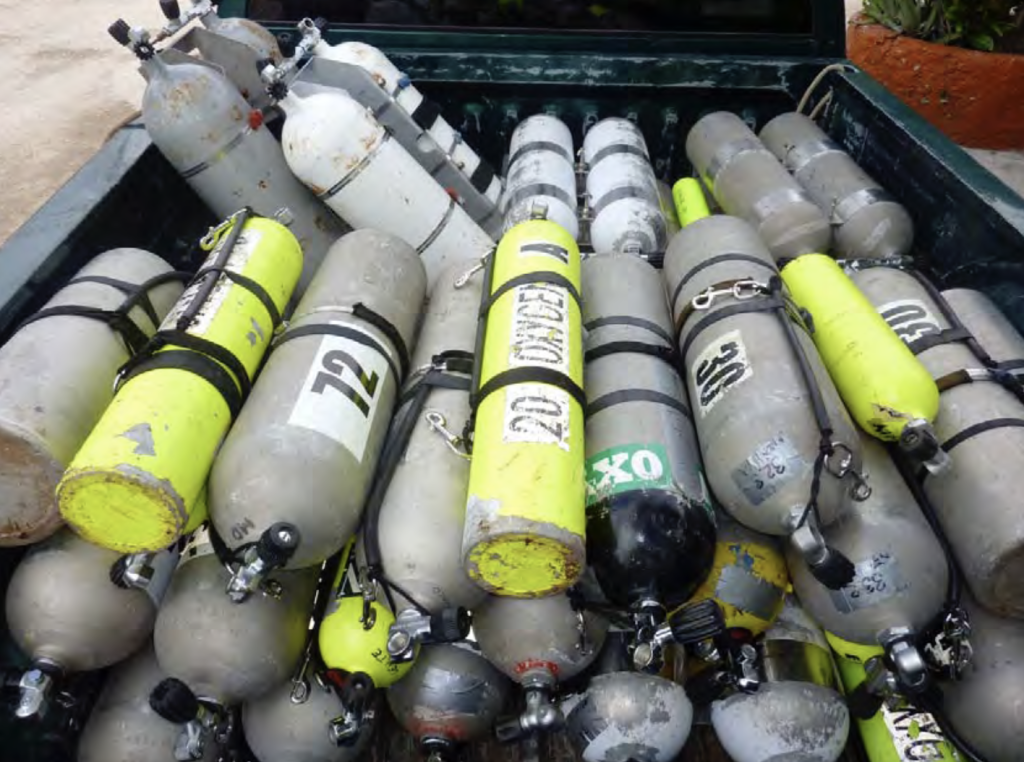
Sendoff
The shallow support team travelled with the exploration team on the initial part of the dive to ensure that things went smoothly and there were no issues. They may also assist the exploration team into and out of their gear.


Waiting for exploration team to return
The shallow support team checked periodically for the return of the exploration team, greeting them, ensuring everything went according to plan, and offloading any unneeded equipment.


Assisting Exploration Team Into the Habitat
The shallow support team also assisted the exploration team out of their rebreathers and into the habitat when appropriate.
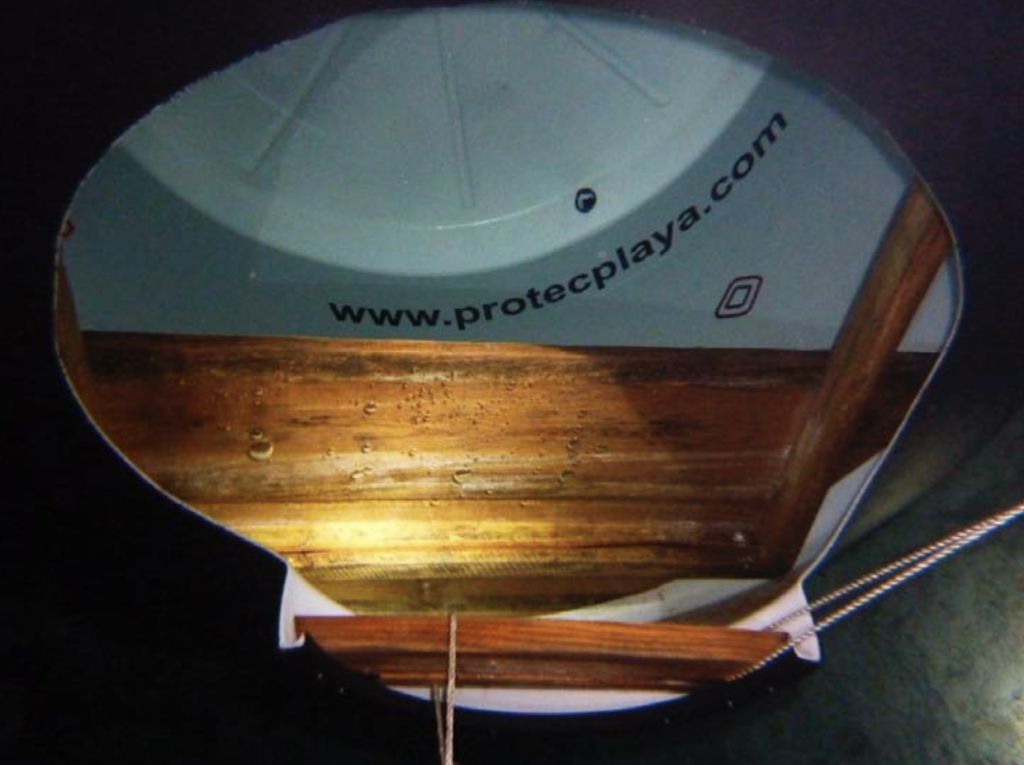
Habitat support
While in the habitat, it was essential that all exploration divers were monitored continuously; this was one of the most dangerous parts of the dive, when the potential for oxygen toxicity or even DCS even was at its highest.
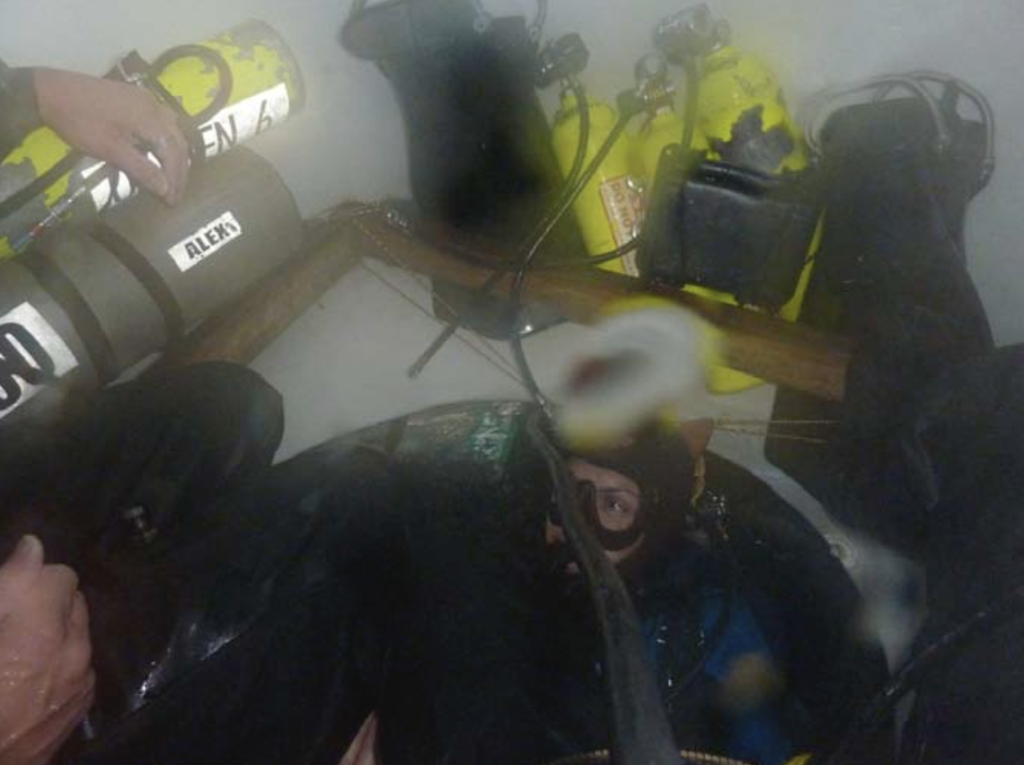
Escorting to the surface
Finally, when the decompression was complete, the shallow support team assisted the exploration team to the surface and supported them as needed.
Dive Reports
Shallow Support by Nick Ambrose
My daily responsibility during the 2009 Pit Project was as Surface Manager, shallow support and logistics.
Day 1: The first day was setup the rebreathers and an orientation day. We inspected the pulley system, verified that the habitat was still in place and functional, and determined the location of the drop points for the 21 and 36 meter depots.
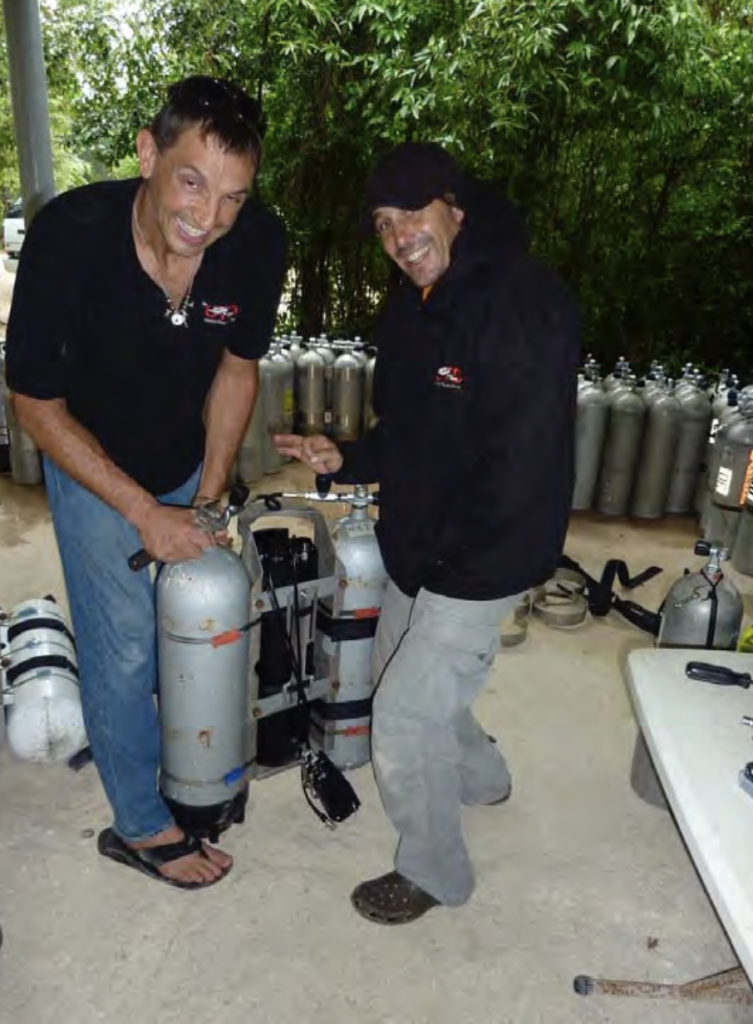
Day 2: The exploration team’s goal was to make a test dive, place some scientific equipment into the cave and verify that everything was working.
In support, my team was required to place the following gear into the cave.
2 AL80 deco bottles at 120ft/36m
2 X-Scooter Cudas at 120ft/36m
2 AL80 deco bottles at 70ft/21m
O2, weighted backplate, argon and spare lights into the habitat.
In the end, this dive was delayed due to a gear issue, and the habitat was not required. As shallow support, we met the divers at three different stops:
1) 120ft/36m stop; verifying the divers’ decompression schedule.
2) 70ft/21m stop; confirming that the habitat was not needed, and that all was well.
3) 20ft/6m oxygen stop: escorting the divers to the surface.

Day 3: The exploration team planned their initial push dive for the evening.
My team was assigned the task of monitoring the cave at 120ft/36m to determine when the exploration team was returning, and to do the initial meet and greet if necessary. Since the dive was planned for a three to four-hour bottom time, we did not expect to see the team returning during our shift.
However, approximately an hour and a half after departing, we saw lights returning and descended to meet the team.
They indicated that there was some issues, but that everything else was satisfactory. We were given the estimated time that the team would reach the habitat and went back to verify that all the required equipment had been placed within the habitat.
However, the exploration team had decided not to use the habitat resources as that might have reduced the chance to attempt a second push dive the next day.
We rescheduled a push dive with the same profile for 6:00pm the following evening.
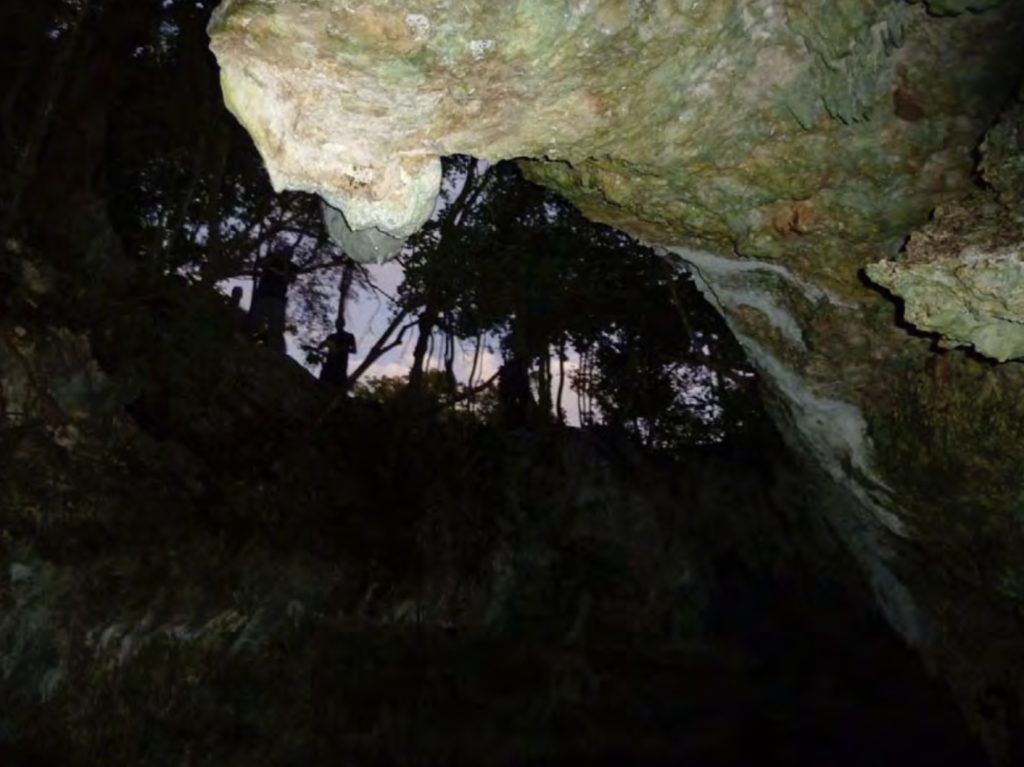
Day 4: The exploration team set off at approximately 1:00pm with an expected bottom time of three to four hours, and a total best scenario runtime of nine to 12 hours.
I was part of the sendoff team, which involved helping the exploration team into their rebreathers, and descending with them until 120ft/36m to verify that everything was in good order . I also took the opportunity to shoot some video of the exploration team descending.
This time, we saw no lights at our 1.5 and 2.5 hour checks, indicating that the dive was going well.
After exiting the water, I was assigned the task of Surface Manager, which I held until both divers surfaced around 10:00pm.
Once lights were spotted, the shallow support team was deployed to meet the returning divers. The exploration team had already pulled all of the deep bottles out of the cave, and handed off all the safety decompression bottles (6 AL 80s) and all four scooters to the shallow team.
Everything that was used and/or empty was removed from the site, but full bottles were left in the water in the case of an emergency.
A schedule for entering the habitat was communicated, and the shallow divers deployed on time to assist both exploration divers into the habitat.
A final shallow support team was then deployed to assist and monitor the divers while in the habitat, bring them food and water, and assist them on their final ascent to the surface.
Finally, after approximately nine hours underwater, the exploration team safely emerged. In addition to the planned tasks, the team discovered a new tunnel deep within “The Pit.”
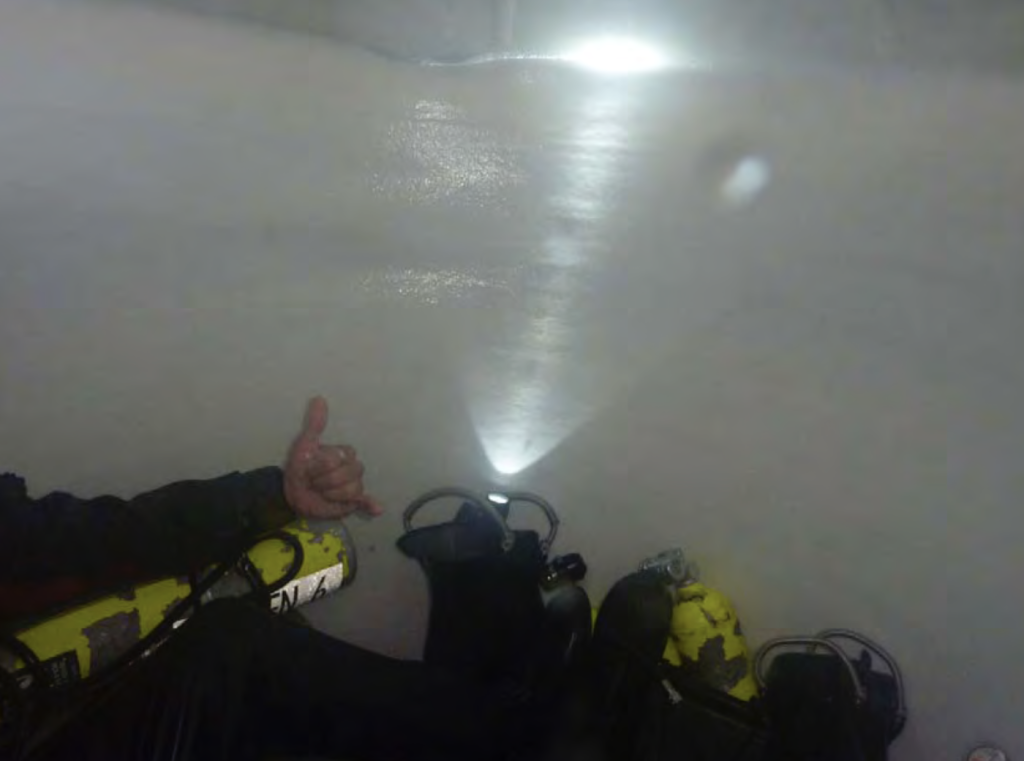
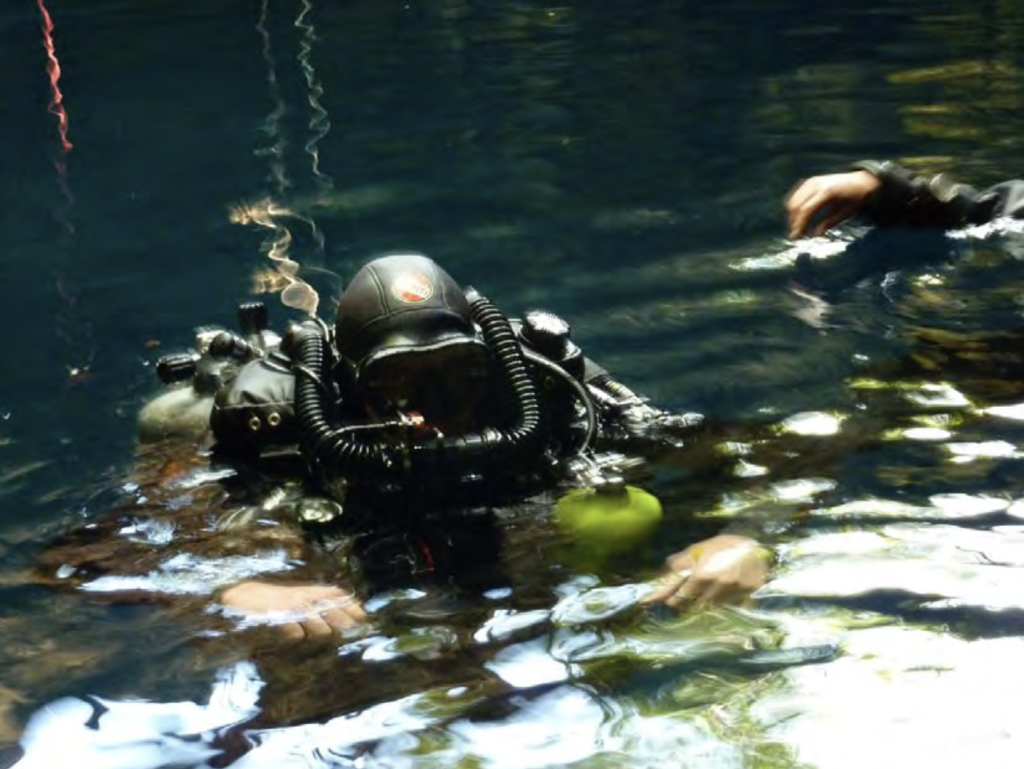
Overview of the Exploration & how we used the MC Rebreathers: by Andrew Georgitsis
The 2009 UTD /EJPP (Ejido Jacinto Pat Project) Pit project was a great success and we certainly built upon our previous experience diving this cave (project) for the last 10 years. Sometimes pulling these dives off may look effortless but in reality what makes these dives run so smoothly is the great team work demonstrated by the entire UTD Cave Diving Team. They did a phenomenal job with surface support as well as setting up the shallow and deep water support.
As far as the final “Push” dive is concerned, the dive was simply an extension of not only the years of diving this cave using first open circuit and now fully closed rebreathers, but it was also a week of great setup dives and the progressive penetration of the rebreather team who were tasked with ensuring that the CCRs were up for the job at hand.
The Exploration Team was using closed circuit technology using the UTD MC Expedition Rebreather.
The MC series of mCCR rebreathers was co-designed with Custom Rebreathers to incorporate the best of both worlds; the advantages and simplicity of the mCCR world and the advantages and consistent configuration from the UTD/DIR world.
To understand the configuration one must understand that we are integrating two full diving systems, the UTD/DIR and mCCR diving. We dive the mCCR as the primary system and capitalize on its advantages while preserving the safety and gas management philosophy inherent to the UTD/DIR philosophy as the bailout or secondary system. In both cases we use Ratio Deco as the decompression strategy. We use rock bottom in the backgas/diluent filled with standardized gases and we use standardized decompression gases for the OC bailout during decompression. We average our PPO2 of the MC90 of 1.0 or higher, ultimately shooting for a constant PPO2 of 1.2 on the shorter dives and driving down from there as the dives become longer. This will allow us some variance when utilizing Ratio Deco.
Ultimately we keep the diving and training philosophy of UTD and incorporate the skill set from the UTD open circuit diving. This then makes it consistent with previous training, philosophy, skill set and ultimately compatible with other UTD/DIR CCR Rebreather divers, with other UTD/DIR Semi Closed Rebreather divers and with other UTD/DIR Open Circuit Rebreather Divers.
Let me explain in detail how the MC Expedition Rebreather performed flawlessly throughout “The Pit” Project and how it helped us accomplish our goals during the “Push” dives.
As far as bailout is concerned, let’s first discuss the gas requirements. For our backgas / bailout / diluent we carried a standardized back gas of 10/70 for the probable maximum depth of 350’ / 110m. This would give us a max PPO2 of 1.2 and the narcotic equivalent of 100’/30m. We would then each carry enough bailout volume to bailout to the Open Circuit and exit to the safety stages, knowing we still have our buddies Open Circuit bailout if needed.
We staged safety bottles / decompression tanks in the cave to give us many options if we experienced any issues at any point during the dive; and because this cave has a maximum known depth of over 350’ / 110 m—and the exploration could take you anywhere in the cave–it was necessary to plan very carefully and ensure that as many safety precautions were in place as possible.
First, we placed standardized open circuit decompression bottles and gases at the O2 Habitat, so we had Oxygen at 20’ / 6m, Nitrox 50 at 70’ / 21m, 35/25 at 120’ / 36m, 21/35 at 190’ / 57m, 18/45 at 240’ / 72m, enabling us to easily and safely return to the habitat on Open Circuit, where we could do O2 deco.
This is one of the strengths of running
CCR Ratio Deco (Decompression
“On the Fly”) while using the UTD
standardized mixes as bailout. The decompression is standardized and consistent and can easily be calculated on the fly and then managed accordingly. There is no need for multiple tables or computers; and sidesteps the possibility of utilizing wrong strategies towards completing the deco. Later I will highlight some variances in the numbers on how we do decompression versus how others might calculate their decompression schedules for the profiles we executed during this project.
All bailout & Open Circuit decompression bottles not only had a first and second stage for OC bailout but also had an extra LP hose with a male QC4 nipple attached, so they can be plugged into the rebreather if needed and used in multiple ways. It could be used as straight diluent if the rebreather is working 100% (Closed Circuit Rebreather (CCR) mode) or if the O2 sensors (or gas analyzation system) has failed then we could extend the use of these gases by running them on the rebreather in a Semi Closed Circuit Rebreather (SCR) fashion– simply running a 1:5 ratio which by calculation and experience, we would ensure that the PPO2 would not drop enough to effect the decompression. Ultimately if the rebreather is flooded or completely failed we would just run Open Circuit.
We then staged a bailout O2 tank with a QC4 male nipple that can be plugged in the O2 Bi-Feed at the last safety tanks (240‘ / 72m). Therefore, if we had a problem with the O2 tanks at max penetration and/or depth we could run the rebreathers either off our buddy’s O2 bottle or off the Backgas/Bailout/Diluent as needed.
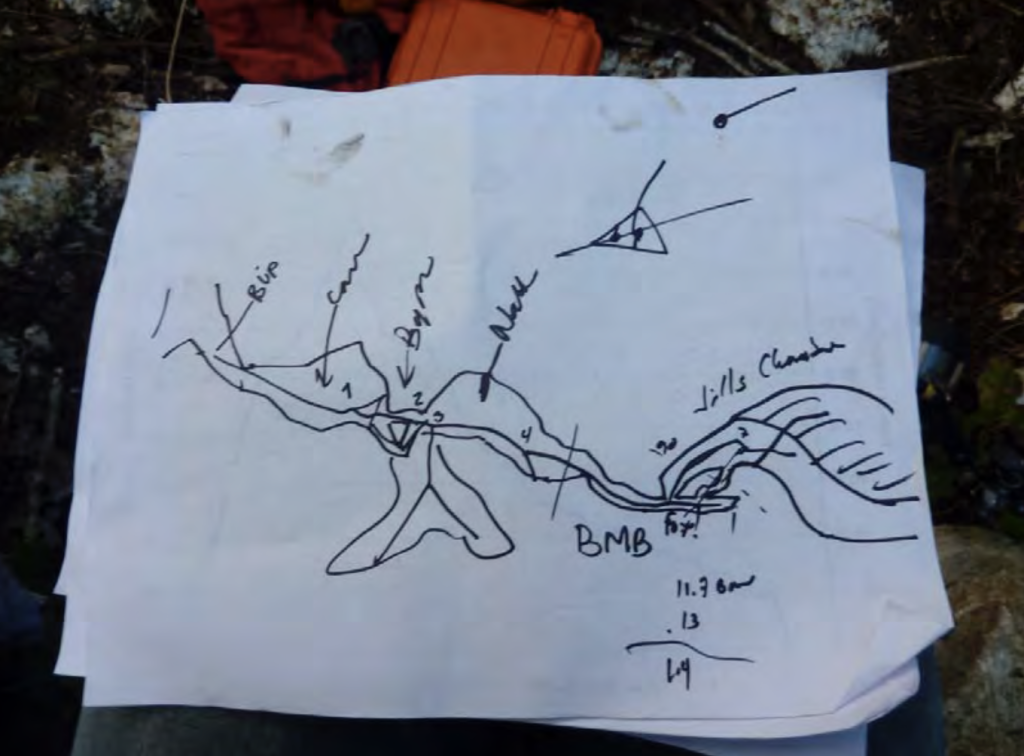

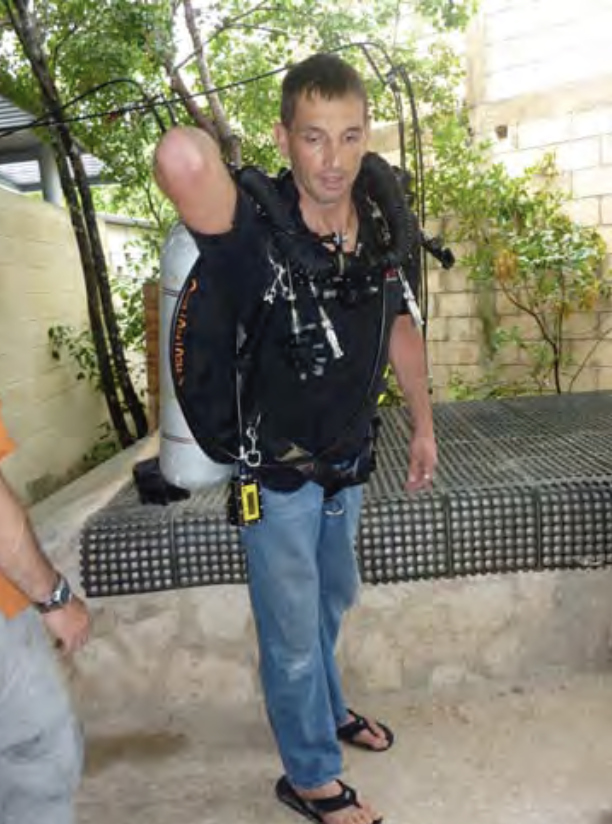
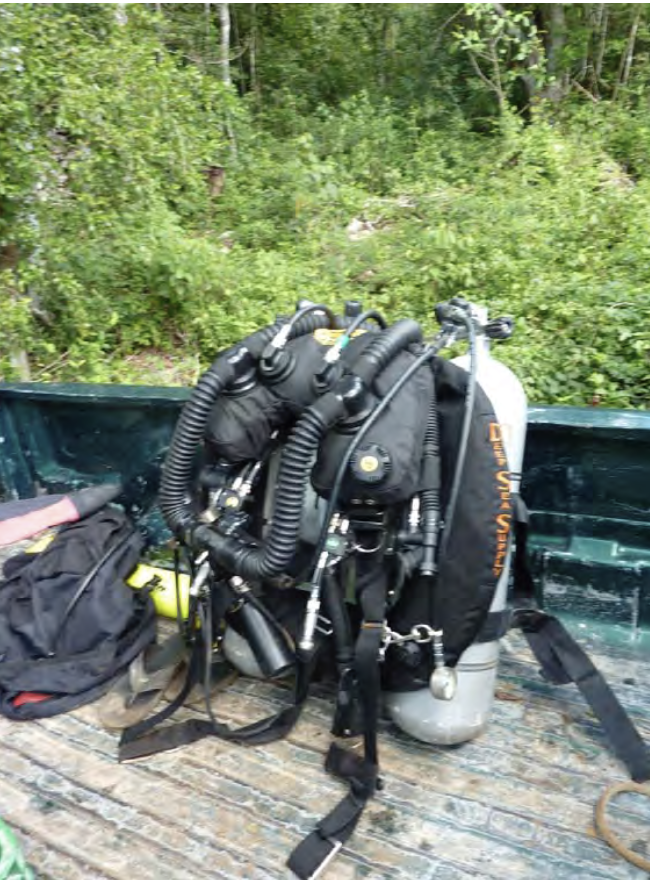
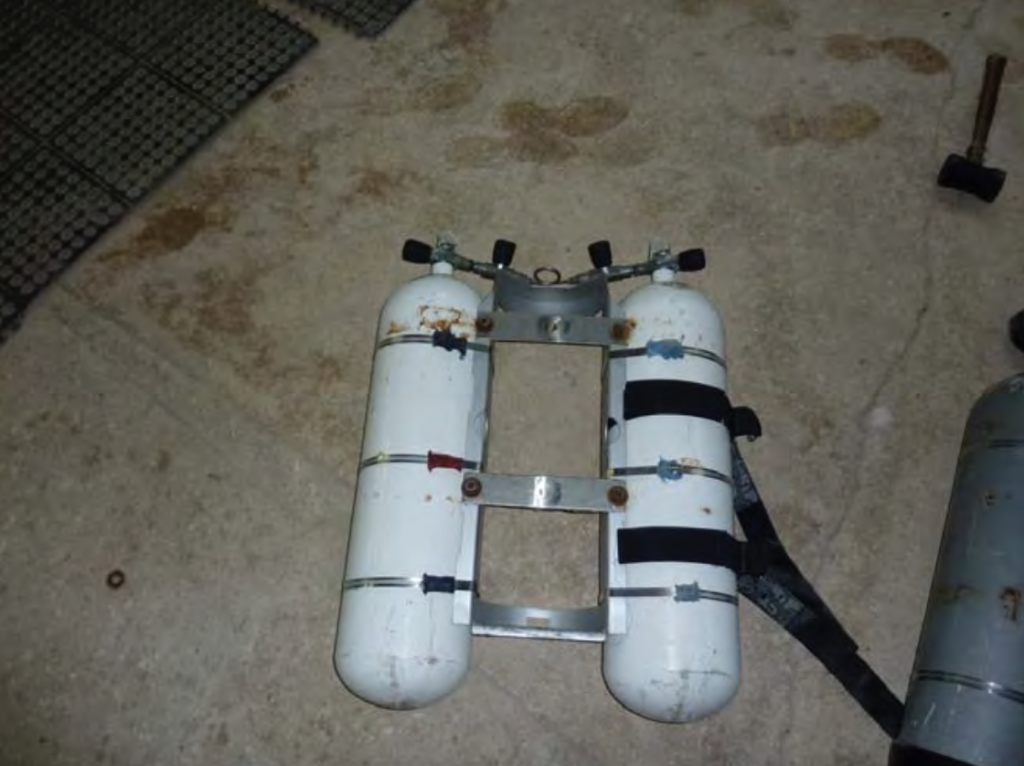
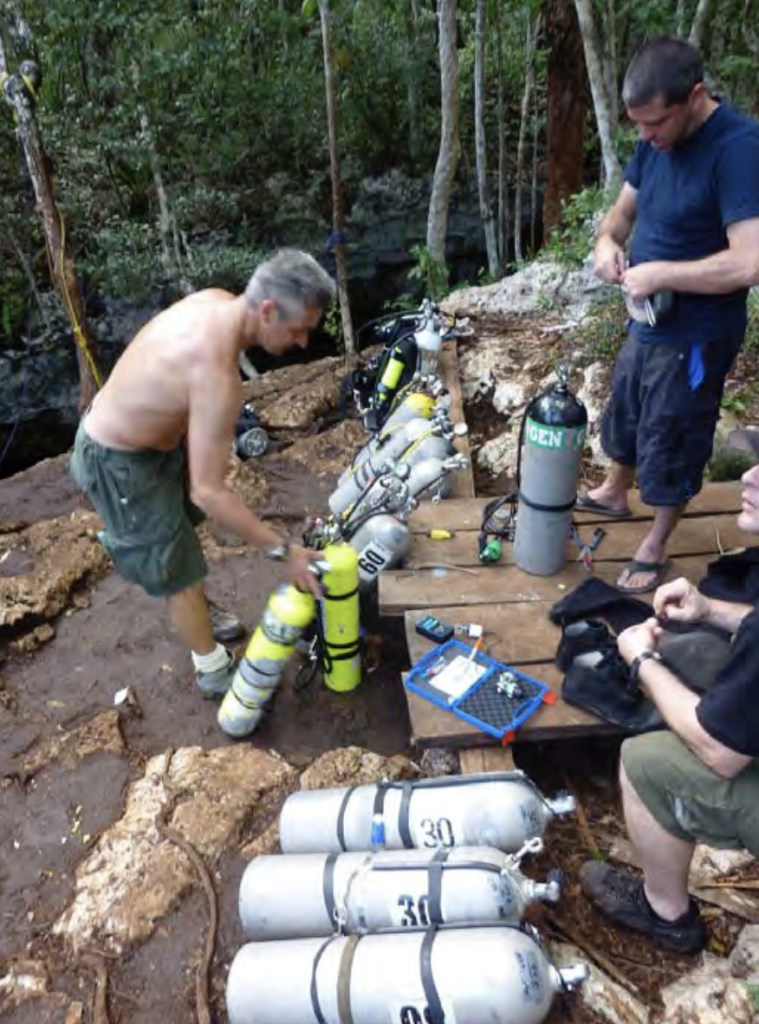
Each of the off-board O2 bottles we were carrying had a QC4 male nipple to drive our rebreather and an Open Circuit second stage for OC bailout. And if we needed to, we could remove the second stage and attachan QC4 male nipple to the LP hose (we always keep these extra QC4 male nipples and a wrench in our left pocket for these exact reasons). This allows both divers the ability to run the rebreathers from a single O2 bottle if required. Alternatively, if we lost the O2 and could not use our buddy’s O2, we could simply run the rebreather off the bailout/backgas/diluent (we carry enough for OC bailout so we have ample) and just add fresh backgas diluent as needed to keep the PPO2 at 0.7 or above. An important point to stress is that we always use standardized backgas/ diluent/bailout so at our max depth (potential depth in this case) the backgas has a PPO2 of 1.2. Depending on your workload this would take quite some time for the PPO2 to drop from 1.2 to below 0.7 from the metabolism and if we are ascending we would be flushing backgas/diluent anyways. If the O2 sensors were bad or we had a failure in the rebreather analyzation system we would simply use the Rebreather as an SCR and keep adding the backgas/ Bailout/ Diluent using a ratio of 1:5 again. If the rebreather was flooded or down (CO2 absorbent was bad) then we would simply use the backgas to bailout to fully Open Circuit and get back to the OC safety bottles at 240’/72m. We had calculated that we would each carry enough bailout gas for both dives to go from the furthest point in the penetration of the cave back to the safety bottles; knowing of course that our buddy was also carrying enough for them to get back on OC as well–OC bailout would of course be the least desirable.
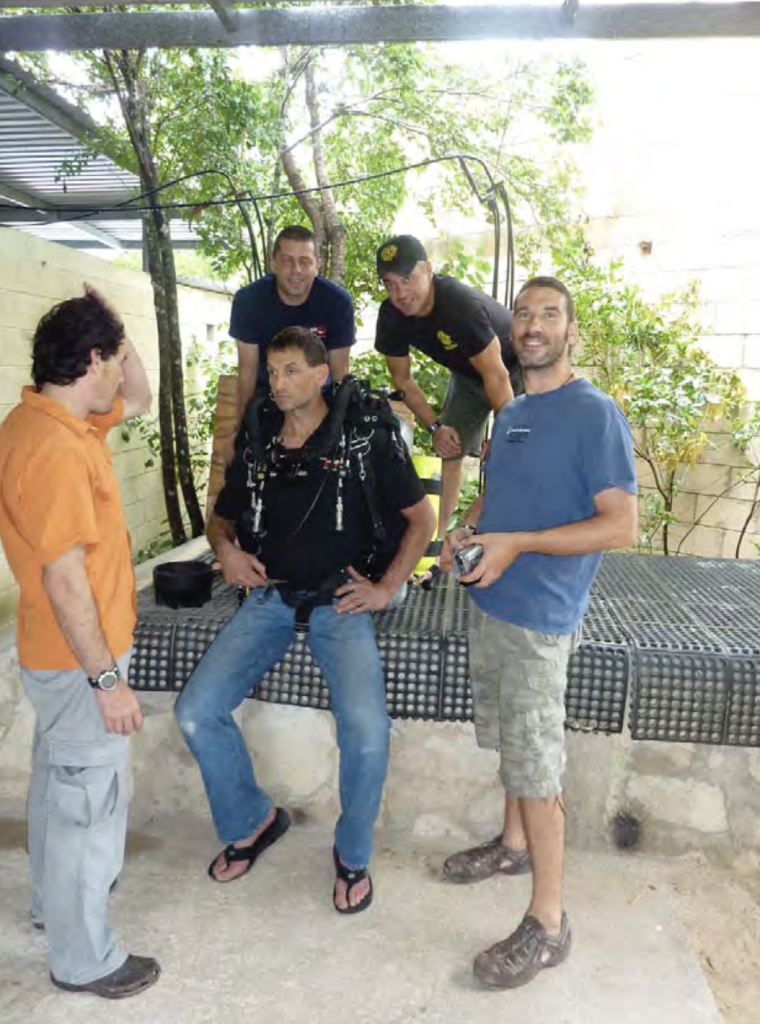
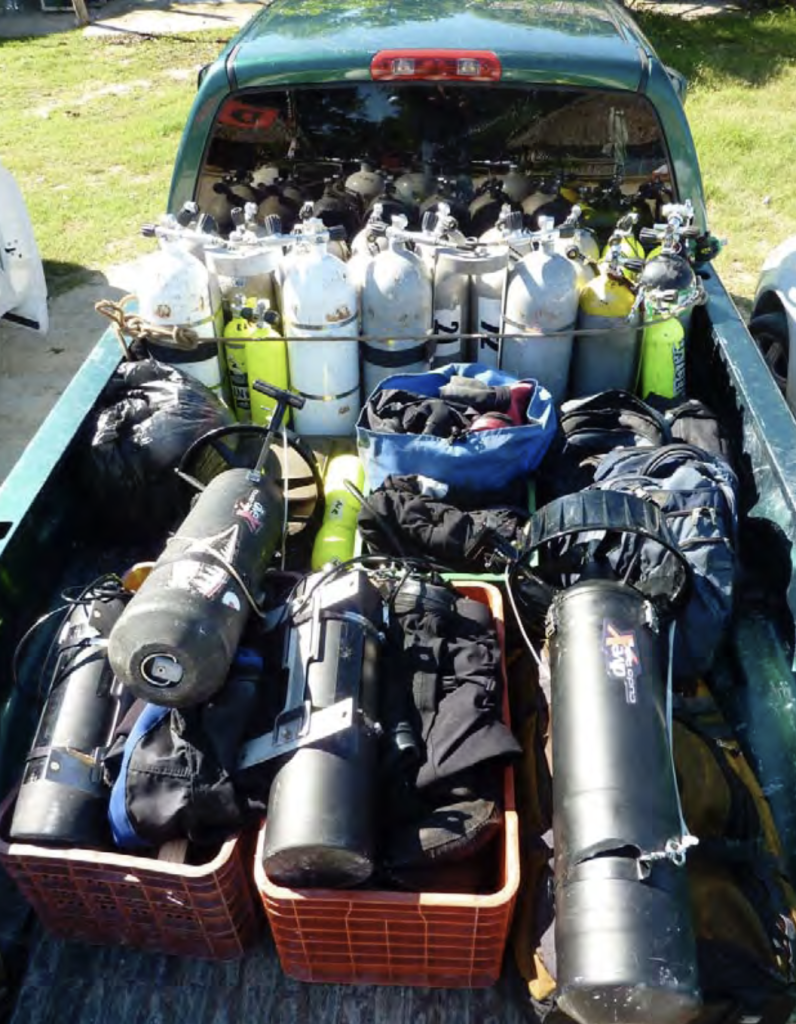
Due to the amount of equipment being carried into the cave in addition to increasing dive efficiency– Scooters (Diver Propulsion Vehicles or DPVs) were utilized for the exploration while diving “The Pit”. The scooters chosen for the project were the Dive Xtras CUDA’s.
These cave exploration style scooters have been tested to over 620’ / 200m so they have proven to be more than capable at reaching the depths that we were diving. We ran them at a penetration speed of 3 which gives us 180 minutes (3 hours) of power. If one diver’s scooter was to fail, we could easily tow our buddy at the same speed by gearing up to a speed of 5, and tow each other back to the 240’ / 72m safety drop where we had staged backup CUDA’s.
As a side note: The CUDA’s have been repeatedly tested, and at a speed 5 they can tow the two divers at the same speed as on speed 3 but for 120 minutes. Based on these numbers, we calculated a maximum penetration time of 60 minutes starting from the backup CUDA’s at 240‘ / 72m based on saving the other two-thirds to return to the backup scooters.
From a configuration point of view, the MC Exploration Rebreather proved to be flawless during the project. We kept to our standard UTD/DIR configuration for the right post and the left post configuration, integrating the two systems.
On the right post, the 7ft /2 m hose can be donated to your buddy in an OOA situation. The 7ft /2 m hose is also on the non roll off post so when passing through any restrictions you will not accidentally roll the valve “off” if touching the ceiling through the restriction. We also have a fixed isolatable feed from the right post to feed the diluent/backgas to the rebreather. Last but not least, we have the BCD connected to the right post to keep things standard as well. The diluent is isolatable so if the Diluent Feed starts to self add gas we can isolate it through turning off the Omni Isolator and we would still have a usable long
hose. The Diluent Feed also has a QC4 female that is pluggable underwater to plug any gas into the system. As an option, you could plug your buddy’s long hose in and draw from his backgas /diluent if needed or simply plug a safety bottle in. The right post has an on “off” valve for the first stage as well as an isolator to shut off that side if the left side fails; enabling us to save the gas from the right tank.
On the left post we have the Bailout Valve (BOV) which acts as a bailout to Open Circuit backgas which has our standardized mix and enough to safely return to the next available Open Circuit gas. It could also act as a diluent addition system if the right post had failed by simply switching between OC and CC. The idea would be that when diluent is needed, switch to OC breath in, then switch back to CC and exhale.
Also on the left is the SPG telling us how much pressure is in the backgas/bailout/ diluent tanks. The left post also has a standard tank valve shutting down the first stage and an isolator allowing you to isolate that side form the right side if needed. We run dual isolation so that if the isolator was to fail we can save both tanks of backgas / diluent.
Final Dive Preparation:
As far as the dive was concerned, we had originally planned to enter the water around 5-6pm and exit the following morning. The idea was to lower and retrieve the equipment during the daylight hours. As the project progressed we figured out the logistics and that it would be quite doable to drop and retrieve gear and divers during the night. There would be no need to conduct the exploration dive throughout the night as we first thought. Therefore, we decided to do the final dive starting during the day.
We entered around the water around 1:00 pm and everything looked positive. Surface support helped us climb into our gear; and our MC Exploration rebreathers were ready to go. As all of our gear had to be in top shape; we began going through our UTD Pre- Dive Checklist followed by checking all of our equipment.
This exploration really made us think through our equipment configuration as well. Because of our dive exposure, we took some unique precautions to make sure that the equipment we used would help us accomplish our goals.
Though the in-water temperature in the Pit was 79 degrees, we made the decision to use drysuit heating units. This decision was not based on the bottom time and depth exposure in-itself; it was based on enhancing our decompression obligation by keeping us warm during such a long in-water exposure. It really did make a big difference and I am very pleased with how it performed.
For our lighting requirements, we were using Exploration LED technology and we had the most versatile lights available on the market today; it really helped our exploration planning.


Both Nick and I carried an entire separate lighting system in our left pocket, making the complications of a possible light failure during the exploration dive very manageable. In addition, we also had the option of swapping out canisters and redundant light heads underwater during the dive. Although we didn’t end up using any of the redundant light sources, the choices that we had (and knowing that back up options were on hand) really made the exploration enjoyable.
Once we completed our final checks before beginning this nine to ten hour dive, we brought our PPO2 up to 0.7 for the descent and bottom and did our 5 minute pre-breath and scooter test run. We configure the MC Series Rebreather Diluent/Bailout Backgas with one of our standardized mixes, so essentially when we are at max depth we have a max PPO2 of 1.2 or 0.7 for long exposure dives. Because of the long bottom exposure of our dive, we kept our PPO2 at 0.7 throughout the bottom portion of the dive to ensure that we saved our lungs for the deco portion.
We used an off board O2 supply bottle (40cf AL) to manually add O2 to the system to bring up the PPO2. We did not—and I stress did not– have any solenoids or O2 injection systems or even slow bleeds of O2 into the system. In my opinion, the “automatic” gear adds massive risk to the dive and the potential for the dreaded “O2 Spike”. We simply build our awareness as competent divers and we have complete control over the addition of O2. This is a key component to our safety much like our standardized backgas bailout.
We also only use a standard first stage, not a fixed IP so that we can use the O2 at any depth and we are not restricted to the approx. 280’/84m depth limitation when using a fixed IP that is set to 135 psi / 9.5 bar to give a flow of 0.7L per min through the Constant Oxygen Pressure Injection System (COPIS). The COPIS was not used during the bottom portion of the dive as the only PPO2 drop is in the metabolism which can easily be accounted for by manually adding O2. (We have an Omni Isolator on the COPIS addition hose) During the decompression portion of the dive we can turn on the COPIS (by flipping the Omni Isolator on) and then the COPIS can try to keep up with the falling PPO2‘s due to the metabolism, the off-gassing of the diver into the loop and the ascent. Of course standard flushing of the loop and constant manual management of the PPO2 is still required at each of the 10’/3m stops during the ascent.
The Push Dive:
As we descended and scootered towards the entrance of the cave, we only needed to add diluent to make up for the counter lung volume decrease; this prevents any spiking of the PPO2 during the descent as the diluent we had is breathable at any depth. As we passed each of the open circuit stage safeties at 70ft/21m, 120ft/36m, 190ft/57m and 240ft/72m, we stopped to double check them. We confirmed that they were pressurized, had gas and were all turned off. This was also a good time to double check that everything was functioning well on the rebreathers and that the PPO2 was well within our safe zones (below 1.0 and above 0.5).
After the final checks of the decompression safety bottles, safety O2 bottle and backup scooters at the 240’ / 72m drop, we followed the line and descended taking the “T” that leads us to the shallower tunnel at the 300’/ 100m mark or so. We slowly worked our way through the “Bypass Tunnel” which is a tight restriction. This tunnel extends for approximately 100’/30m and because we were diving the CCR’s, we now had zero perculation. Additionally, our profile and drag compared to the OC dives done previously was very low and we did not disturb any silt, leaving it perfectly clear for our exit.
The “Wakulla” room is truly a unique experience for any diver. To call it massive doesn’t do justice to the enormity of the room. We were in a chamber with measurements from anywhere from 300ft/90m-350/110m on the floor to 240’/72m on the ceiling. And as we entered into this famous room, I remembered thinking to myself how incredible it was and how happy I was to be back here
It was also so much nicer this time to reach this point from “The Pit” entrance at 5000’/ 1800m , since the last time we did this dive we were on also on a rebreather but we had to dive it from the Dos Ojos entrance and had scootered almost 15 000’ / 4500m in order to reach this same point.
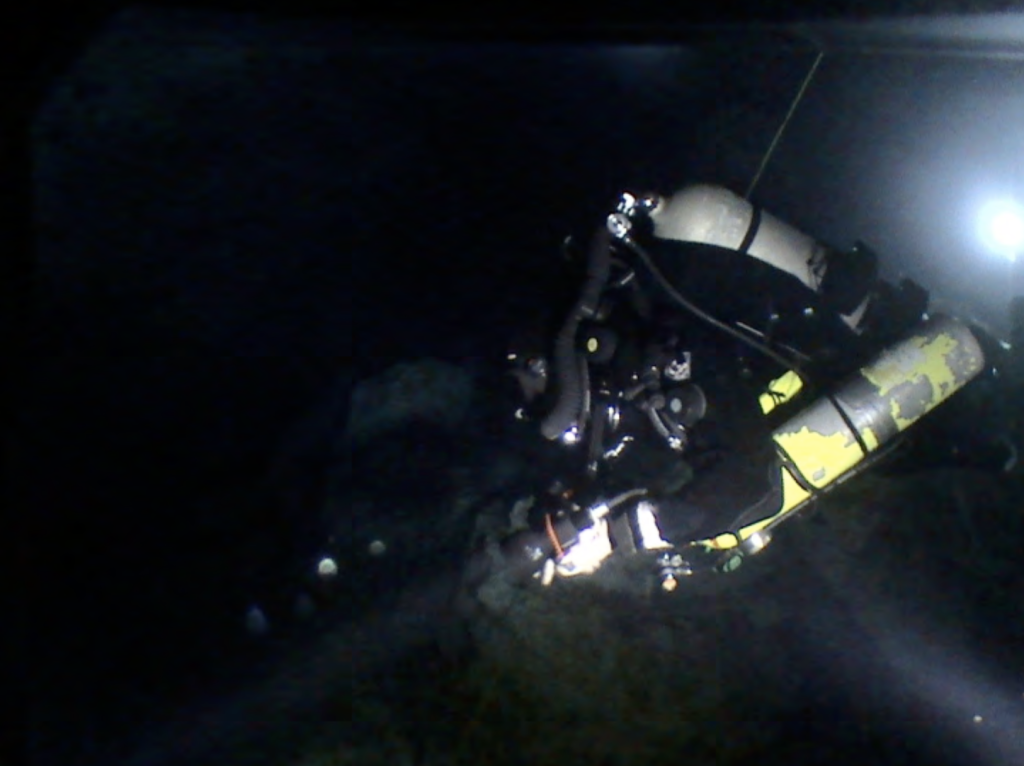

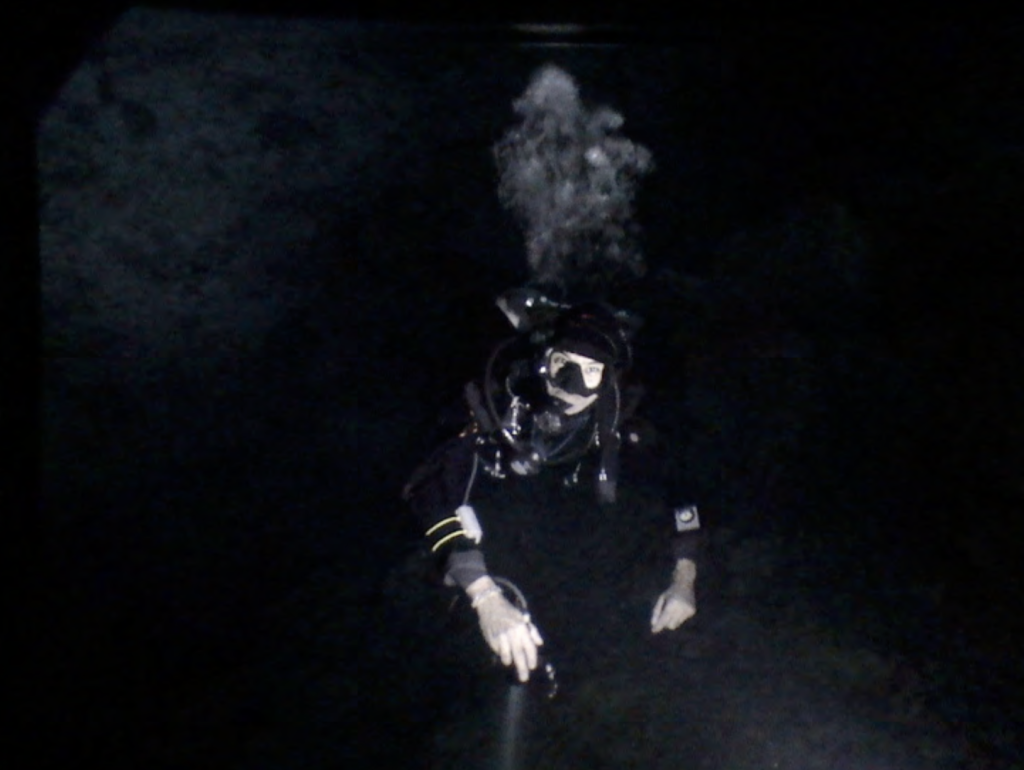
As we followed the line we dropped cookies on the exit side of the T’s from previous explorers looking for leads. We continued to slowly work our way along the exploration line, marveling at the sheer size of the room, and examining the various exploration lines that T off. We then pushed on into the BMB tunnel. At this point you drop from the 300ft/90m down the pile to about 350ft/110m in order to enter this longish restriction. Again, we wanted to slowly work our way through the restriction so as to not disturb any silt.
Once again, the way out was in crystal clear water which was much different than before; on OC, peculation resulted in a “no vis” area exit. Using the CCR’s left us with clear water every time; almost as if no one had passed through at all, Not only, did this provide for more accurate data collection s(as previously mentioned) but it also simply added to the enjoyment of the dive.
On the way back, the real work began as we re-entered the “Wakulla” Room and started to measure the area and collected water sampling data. We worked each of the previous team’s exploration lines, and measured the distances to and from the walls and up to the roof. The idea was to start collecting the data needed to build a 3D map. This also doubled nicely as the Aqualab was going slowly throughout the entire area. We also spotted a new tunnel to be explored during the next project. After an hour of penetration and an hour of survey in the “Wakulla” room, we headed back through the by-pass restriction and then into the Cardea Passage.
In the Cardea Passage, we spent the better half of 30 minutes continuing to survey that area until we reached our first deep stop at the 240ft/72m drop after about 30 minutes. Our runtime at this point
was 150 minutes. It was amazing to realize that we had done over 2.5 hours at an average depth of 300’ / 90m.
One of the best feelings I had during the dive was knowing that every time we did a gas check we would break out chuckling at how little gas we had used and how much reserve we had at any one point during the dive. This was very comforting for the entire exploration team.
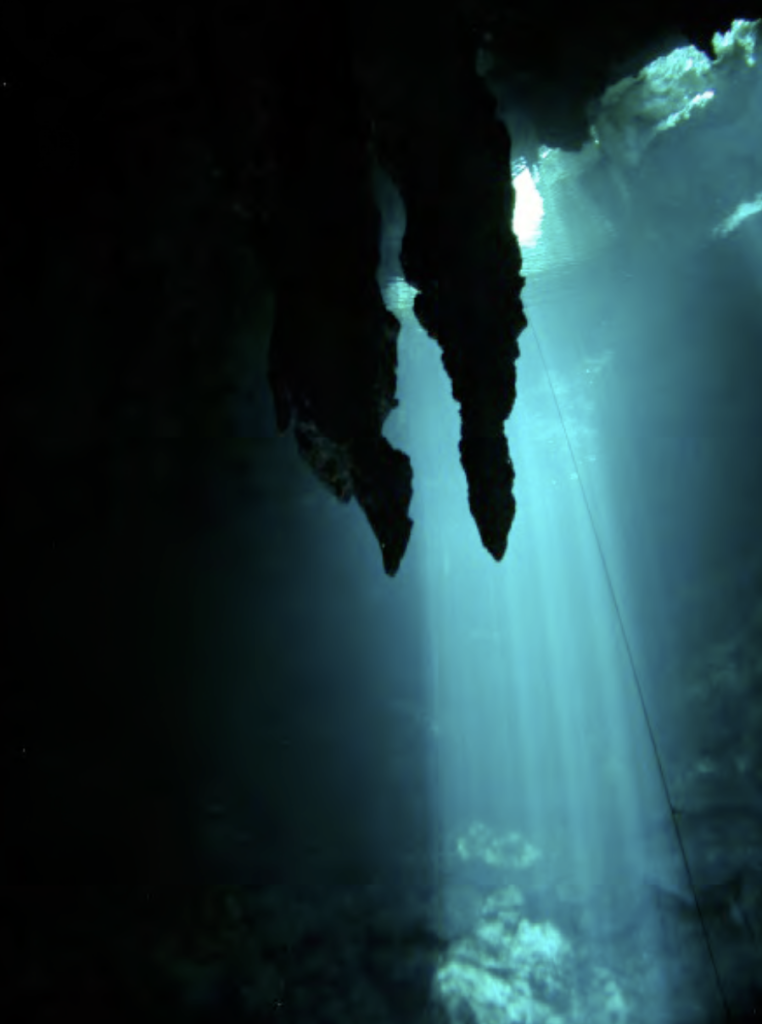
The Decompression:
For our dive we averaged our bottom depth of 300’/90m for 2.5 hours bottom time with a back gas mix of 10/70.
We ran “Max Deco” for the deep stops portion of the dive and then used CCR Ratio Deco for the rest.
We kept a PPO2 of 1.0 in the deeper parts of the deco because of the O2 clock. We also ensured that we took a 35 minute “back gas break” at the 80’/24m and 30’/9m stops to address the huge oxygen debt we were incurring. Interestingly, we were able to do all the PPO2 adjustments easily using the CCR and we were even able to do the back gas breaks on the rebreather. We completed the O2 deco in the habitat doing 100 minutes followed by a 30 minute ascent from 20’ /6m to the surface.
When in the habitat, we used 15 mins on O2 and 5 mins on the 240’ /72m mix 18/45.
The reason we chose the standard gas of 18/45 for our backgas breaks was because it was the lowest PO2/highest helium content bottles that we had brought back with us from the deep safety station. This also allowed us to save all of our backgas.
The time calculated for the O2 and backgas break were all counted for within the total 100 minutes. This was shortened from the normal max deco of 150 minutes of O2 and 30 minute ascent as we wanted to test the efficiency of the CCR deco.
The total decompression time was 390 minutes (6.5 hours)
The total Bottom Time was 150 minutes so a total of 540 minutes of in water time.
As a side note to compare:
-Bulhman CCR (Deco Planner/I-deco) calls for 1200 minutes of decompression / 20 hrs.
-Bubble Theory CCR software at constant 1.2 (V-planner) calls for 836 minutes / 14 hrs of decompression.
All divers were asymptomatic after all dives and there were no Decompression Illness cases throughout all of the exploration during “the Pit” Project.
The Dive Specifics:
Rebreather Gas Usage:
For the gas volumes of the dive we used an astonishingly low amount of gas.
For Diluent/Backgas, we used 10/70 = 27cft / 360 liters
For Off-Board Oxygen – 12cft / 450 liters
No Open Circuit stages or safety bottles were breathed throughout the dive
The Equipment Tested:
Rebreathers: MC Series with the long canister and the 8 lb radial canister (Expedition) MC Series with the std canister and 5.5lb radial canister (Explorer)
Drysuit: SANTI & Explorer Undergarment: SANTI
Bottom timer: Liquid Vision X1
Lights: Aton Explorer LiIon 10 amp LED
Heating: Undergarment Drysuit Heater
Scooters: Dive Xtras CUDA
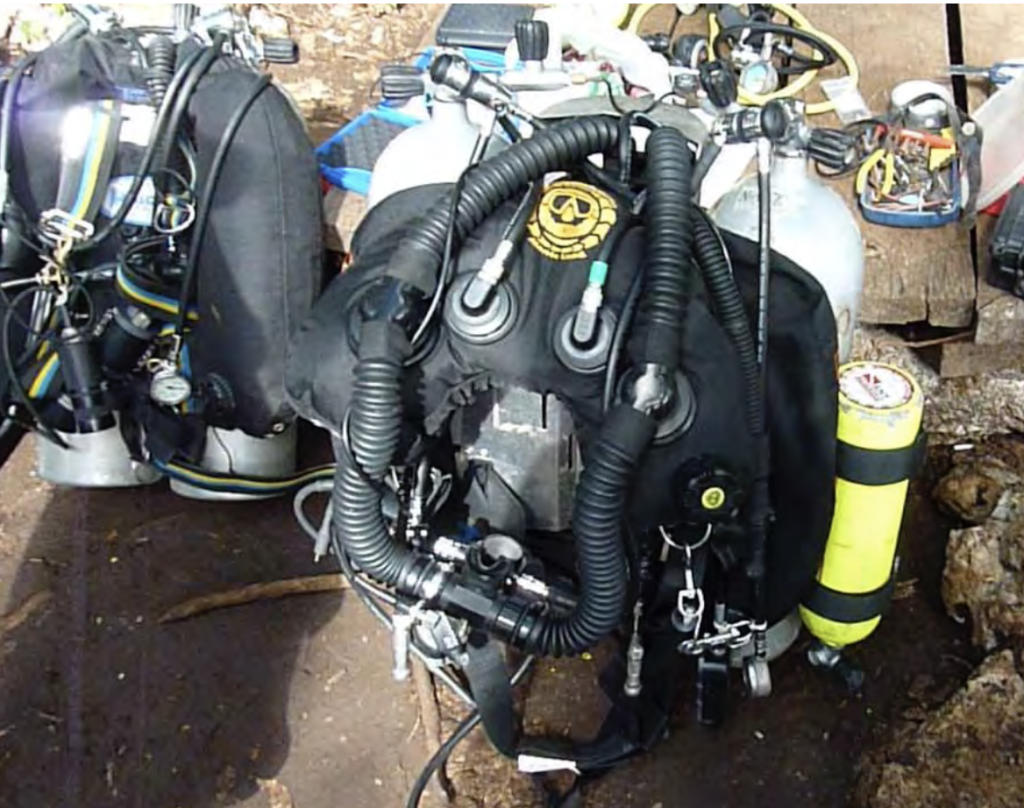
The Findings:
– Collect Scientific Data using the Aqualab – Scientific Paper coming soon
- Moved the monitoring sensors to collect better day – Retrieved last day of project Found new tunnel to explore – Next year November 2010
- Collected data for the 3D map – Coming soon
- Tested CCR in max deco conditions – Worked perfectly
- Tested other new equipment available next year
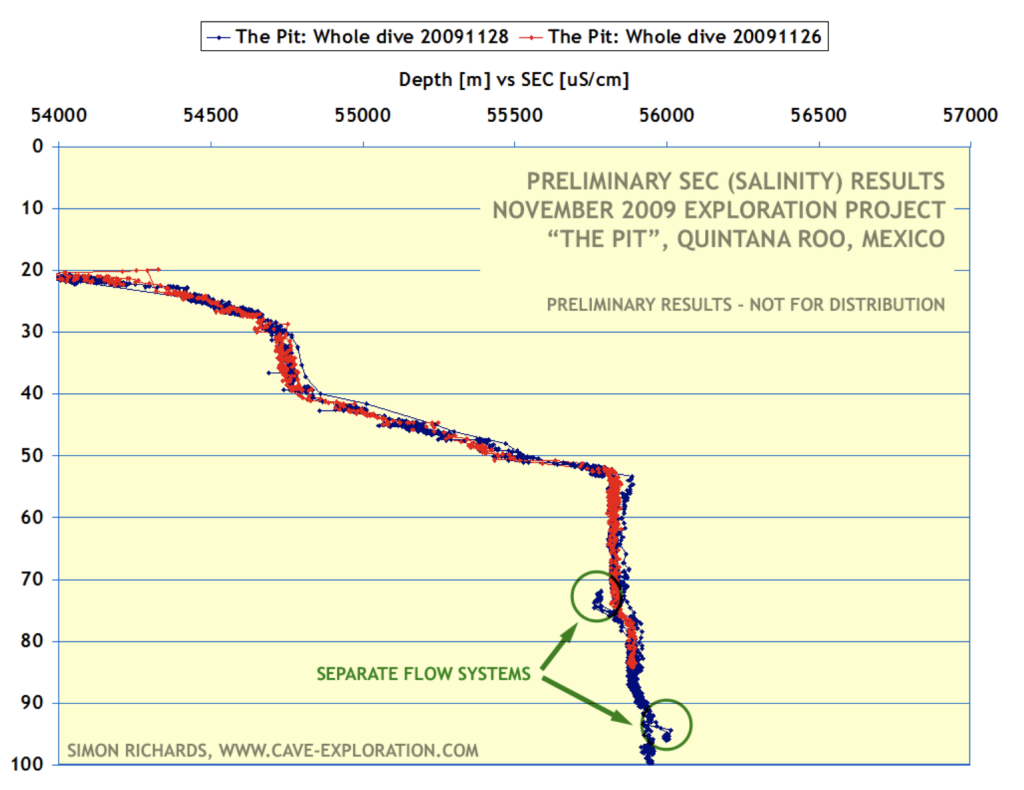
Wrapping it Up
by Project Director Nick Toussaint
Like every Thanksgiving for the last 10 years, we have gathered to dive the “Pit” as part of the EJPP. I am very pleased with the results from this year’s dive; everything ran smoothly and as usual, there were no mishaps..
A special thanks goes to the Dos Ojos Ejido, whom have constructed the road all the way to the Cenote, and thanks to all of the divers who paid their entrance fees, which enabled the road construction to happen. It certainly made a difference driving to the spot with air conditioning, compared to our first trip out in the late 90s that took 13 horses and many hours to reach the cave for just one dive. A road really made all the difference in the world.
This year’s project was special in many ways; even though we are not new to supporting science and research on our dives. We have become pretty standard performing tasks like video documentation, exploration or surveying while pushing the limits of our own equipment and decompression knowledge.
It all went effortlessly with minimal guidance, due to what has become a strong cave exploration team, and specially due to joining forces with the increasing UTD crowd.
There is no doubt in my mind that next year we will have many more rebreather divers. What was also promising was the new equipment possibilities in the future of the EJPP. Obviously this is not the first time we dove this cave with rebreathers and scooters, but I am looking forward to our future projects expanding our equipment philosophies.
Furthermore, I dove the Pit Cave with rebreathers along with Andrew Georgitsis and others in past projects, and it has been quite a progressive, continuous effort and obviously not a one day shot. Actually we began using rebreathers 2001, back when the exploration was kicking off in Dos Ojos cavern, about 10,000ft before getting to the Pit.
I am very excited to have been a participant in the EJPP. Not only was it challenging— teaching me a lot more about the cave and cave diving, but it was also a lot of fun.
I would like to pass on a well deserved “Thank You” to all UTD supporters and supporters of this Project.
I can’t wait to come back next year and hope to see many new faces joining the fun.


Thanks to:
- Protec Playa
- Aqua Caves
- Aquatic Tulum
- Cenotes Control
- Dive Xtras
- Megalodon USA
- Megalodon Brasil